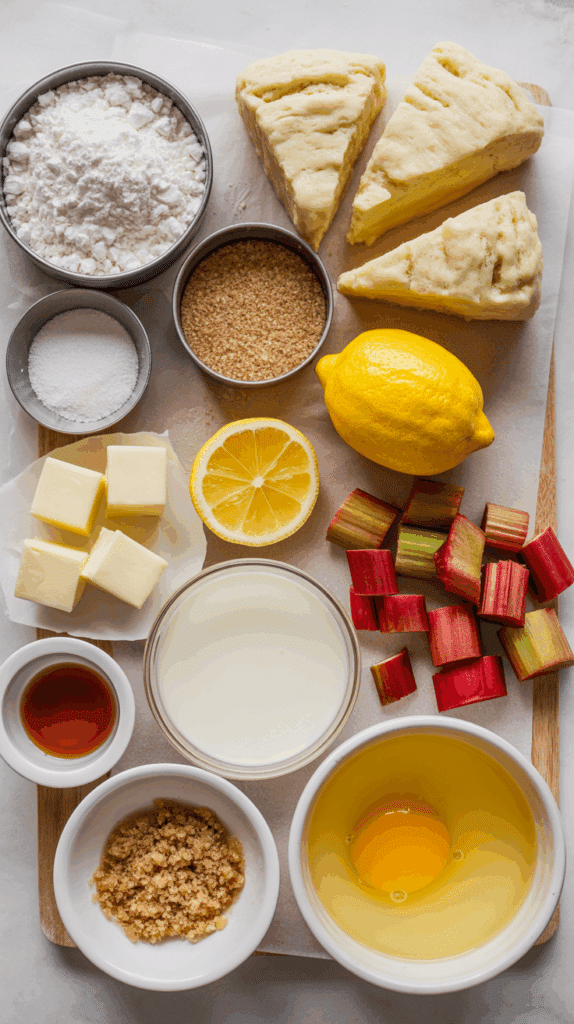Introduction & Inspiration
I am so thrilled to share a recipe that truly lives up to its name: Ridiculously Easy Rhubarb Vanilla Lemon Scones! If you love the tart, unique flavor of rhubarb and the comforting charm of a freshly baked scone, you’re in for a treat. These scones are wonderfully tender, infused with bright lemon zest, warm vanilla, and studded with juicy pieces of fresh rhubarb. The optional sprinkle of turbinado sugar on top adds a delightful crunch.
My inspiration for this recipe comes from wanting a simple yet elegant way to celebrate rhubarb season. Scones are such a classic, and incorporating rhubarb along with lemon and vanilla creates a beautifully balanced flavor profile that’s perfect for spring and early summer. The “ridiculously easy” part is no joke – they come together so quickly!
These scones are perfect for a special breakfast, a lovely brunch addition, an afternoon tea treat, or anytime you want a delicious homemade baked good without a lot of fuss. They are sure to brighten your day! It is a perfect recipe for scone lovers.
Nostalgic Appeal / Comfort Factor
Homemade scones evoke a wonderful sense of nostalgia and comfort for many. They’re reminiscent of cozy tea times, visits to charming bakeries, or simple weekend baking projects. Rhubarb, with its distinctive tartness, also brings a touch of nostalgia, often associated with springtime gardens, family recipes for pies, crumbles, and jams.
This recipe beautifully combines the comforting, buttery tenderness of a classic scone with the bright, familiar tang of rhubarb, enhanced by the classic pairing of lemon and vanilla. The simplicity of the preparation adds to their comforting appeal – truly accessible home baking.
They offer a delightful taste of spring and the comforting satisfaction of a freshly baked treat. A perfect comfort food scone.
Homemade Focus
This recipe is all about the simple joy of homemade baking from scratch, using classic scone-making techniques. You’re starting with basic pantry staples like flour, sugar, and butter, and transforming them with the addition of fresh rhubarb, lemon zest, vanilla, and heavy cream into something truly special.
The homemade focus lies in the gentle cutting in of cold butter to create that tender, slightly flaky texture, and the careful mixing of the dough to avoid overdevelopment. Preparing the fresh rhubarb yourself also contributes to the vibrant, homemade taste.
It celebrates the delicious results that can be achieved with straightforward homemade methods and fresh, seasonal ingredients. The homemade taste is incredible.
Flavor Goal
The primary flavor goal is a delightful balance between the tender, buttery scone base, the tartness of the fresh rhubarb, the bright notes of lemon zest, and the warmth of vanilla. The scone itself should be lightly sweet and rich.
The rhubarb pieces, softened during baking, should provide pockets of tart, fruity flavor throughout the scone. The lemon zest should add a fresh citrus aroma and taste. The optional turbinado sugar topping will contribute a lovely crunch and a touch of molasses sweetness.
The overall experience should be a tender, moist, flavorful scone that perfectly balances sweet, tart, buttery, and citrus notes, with pleasant bursts of rhubarb. A perfect balance between flavour and texture.
Ingredient Insights
- All-Purpose Flour: Provides the main structure for the scones.
- Granulated Sugar: Sweetens the scones.
- Baking Powder: The primary leavening agent, responsible for the scones’ rise and light texture. Ensure it’s fresh.
- Salt: Balances sweetness and enhances the overall flavor.
- Lemon Zest: Adds bright, fresh citrus aroma and flavor. Use zest from about one large lemon.
- Unsalted Butter (Cold and Cubed): Essential for creating a tender, flaky, slightly crumbly scone texture. The cold butter pieces, when cut into the flour, create steam pockets during baking, leading to flakiness.
- Chopped Fresh Rhubarb: The star fruit! Provides tartness and moisture. Dice into small (about 1/4 to 1/2-inch) pieces for even distribution and proper cooking.
- Heavy Cream: Provides richness and moisture, binding the dough together. It contributes to a tender crumb. Buttermilk could substitute for a tangier scone.
- Vanilla Extract: Adds warmth and classic flavor.
- Lemon Juice: Adds a touch more liquid and bright lemon tang, also helps activate leavening slightly.
- Egg (for Egg Wash): Brushing the tops with beaten egg before baking gives the scones a beautiful golden-brown color and a slight shine.
- Optional: Turbinado Sugar: Coarse raw sugar that adds a lovely sparkle and crunchy texture when sprinkled on top before baking.
Essential Equipment
- Baking Sheet: For baking the scones.
- Parchment Paper: Essential for lining the baking sheet to prevent sticking and for easy cleanup.
- Large Mixing Bowl: For combining dry ingredients and cutting in butter.
- Pastry Cutter or Fork (or Fingertips): For cutting the cold butter into the flour mixture.
- Small Bowl: For whisking together the wet ingredients.
- Knife or Bench Scraper: For cutting the dough round into wedges.
- Pastry Brush: For applying the egg wash.
- Measuring Cups & Spoons:
- Wire Cooling Rack: For cooling the baked scones.
Ingredients
(Based on 1x column, Servings: 8 scones)
- ▢ 2 cups all-purpose flour
- ▢ 1/4 cup granulated sugar
- ▢ 1 tablespoon baking powder
- ▢ 1/2 teaspoon salt
- ▢ Zest of 1 large lemon
- ▢ 1/2 cup (1 stick) unsalted butter, cold and cubed
- ▢ 1/2 cup chopped fresh rhubarb (about 1/4 to 1/2-inch pieces)
- ▢ 3/4 cup heavy cream, cold
- ▢ 1 teaspoon vanilla extract
- ▢ 1 tablespoon fresh lemon juice
- ▢ 1 large egg, beaten (for egg wash)
- ▢ Optional: Turbinado sugar for sprinkling

Step-by-Step Instructions
(Prep Time: 10 minutes | Cooking Time: 18-22 minutes | Total Time: ~30 minutes)
1. Prepare Oven and Baking Sheet:
- Preheat your oven to 400°F (200°C).
- Line a large baking sheet with parchment paper.
2. Mix Dry Ingredients:
- In a large mixing bowl, whisk together the all-purpose flour, granulated sugar, baking powder, salt, and 1 lemon zest until well combined.
3. Cut in the Butter:
- Add the cold, cubed unsalted butter to the dry ingredients.
- Using a pastry cutter, a fork, or your clean fingertips, cut the butter into the flour mixture until it resembles coarse crumbs with some pea-sized pieces of butter still visible. Work quickly to keep the butter cold.
4. Fold in Rhubarb:
- Add the chopped fresh rhubarb to the flour-butter mixture.
- Gently fold or toss it in with a spatula or your hands until the rhubarb pieces are evenly distributed.
5. Mix Wet Ingredients and Combine Dough:
- In a separate small bowl, whisk together the cold heavy cream, vanilla extract, and fresh lemon juice.
- Pour this wet mixture all at once into the dry ingredient/rhubarb mixture.
- Stir with a fork or rubber spatula just until the dough comes together and is moistened. Be very careful not to overmix; a slightly shaggy, sticky dough is what you’re aiming for.
6. Shape and Cut Scones:
- Turn the dough out onto a lightly floured surface.
- Gently knead the dough just a few times (4-5 turns) to bring it together into a cohesive ball. Avoid over-kneading.
- Pat or gently roll the dough into a round disc about 1-inch thick.
- Using a sharp knife or a bench scraper, cut the dough round into 8 equal wedges (like cutting a pizza).
7. Egg Wash and Sugar Topping:
- Carefully place the scone wedges onto the prepared parchment-lined baking sheet, leaving a little space between them.
- Lightly beat the egg in a small bowl to create an egg wash. Brush the tops of the scone wedges evenly with the beaten egg.
- If using, generously sprinkle the tops with turbinado sugar.
8. Bake:
- Place the baking sheet in the preheated oven.
- Bake for 18–22 minutes, or until the scones are risen, golden brown on top and bottom, and a toothpick inserted into the center of a scone (avoiding rhubarb) comes out clean.
9. Cool and Serve:
- Let the scones cool on the baking sheet for a few minutes to firm up slightly.
- Carefully transfer the warm scones to a wire cooling rack to cool a bit more.
- These Rhubarb Vanilla Lemon Scones are best enjoyed warm or at room temperature, preferably on the day they are baked.

Troubleshooting
- Scones Tough/Dense: Overmixing the dough after adding the wet ingredients, or over-kneading. Handle scone dough minimally! Also, butter might have been too warm.
- Scones Dry: Overbaking, or not enough liquid (ensure cream measured correctly). Bake just until golden and cooked through.
- Rhubarb Making Scones Soggy: Rhubarb was very wet, or too much rhubarb used for the amount of dough. Pat rhubarb dry if it seems excessively moist after chopping. Ensure proper flour-to-liquid ratio in batter.
- Scones Spread Too Much/Flat: Dough too wet/soft, or too much leavening (baking powder). Ensure butter is cold. Don’t add extra liquid unless dough is truly too dry to come together.
- Uneven Browning: Oven might have hot spots. Rotate baking sheet halfway through baking.
Tips and Variations
- Cold Butter is Key: For tender, flaky scones, your butter must be cold and cut into small cubes. Work quickly to prevent it from melting.
- Don’t Overmix! This is the most crucial tip for tender scones. Mix just until the dough comes together. A slightly shaggy dough is better than an overmixed one.
- Fresh Rhubarb: Use firm, fresh rhubarb stalks. If using frozen rhubarb, use it directly from frozen (do not thaw) and you might need to add 1-2 extra minutes to the baking time. Pat frozen pieces dry slightly.
- Add Spices: A pinch of ground ginger or cardamom would complement the rhubarb and lemon beautifully – add with dry ingredients.
- Different Citrus: Use orange zest and juice instead of lemon for an Orange Rhubarb Scone.
- Glaze: Instead of turbinado sugar, drizzle cooled scones with a simple lemon glaze (powdered sugar + lemon juice) or vanilla glaze.
- Nuts: Fold in 1/2 cup of chopped toasted pecans or walnuts with the rhubarb.
Serving and Pairing Suggestions
- Serve Warm: Scones are always best enjoyed warm from the oven, or reheated gently.
- With Butter & Jam: Classic scone accompaniments. Lemon curd would also be divine.
- Clotted Cream: For a truly traditional British-style experience (though these are American-style scones).
- Breakfast or Brunch: A perfect treat for a special breakfast or brunch.
- Afternoon Tea: An elegant addition to an afternoon tea spread.
- With Coffee or Tea: Ideal pairings.
Nutritional Information
(Provided estimate per scone, assuming 8 scones)
- Calories: ~280 kcal (Further estimation based on typical ingredients)
- Fat: 14-18g
- Saturated Fat: 8-11g
- Cholesterol: 50-70mg
- Sodium: 250-350mg
- Total Carbohydrates: 30-40g
- Dietary Fiber: 1-2g
- Sugars: 12-18g
- Protein: 3-5g
Ridiculously Easy Rhubarb Vanilla Lemon Scones
Bake these Ridiculously Easy Rhubarb Scones! A delightful recipe featuring fresh rhubarb, lemon zest, and vanilla in a tender, buttery scone, perfect for breakfast or tea
Ingredients
Ingredients
(Based on 1x column, Servings: 8 scones)
- ▢ 2 cups all-purpose flour
- ▢ 1/4 cup granulated sugar
- ▢ 1 tablespoon baking powder
- ▢ 1/2 teaspoon salt
- ▢ Zest of 1 large lemon
- ▢ 1/2 cup (1 stick) unsalted butter, cold and cubed
- ▢ 1/2 cup chopped fresh rhubarb (about 1/4 to 1/2-inch pieces)
- ▢ 3/4 cup heavy cream, cold
- ▢ 1 teaspoon vanilla extract
- ▢ 1 tablespoon fresh lemon juice
- ▢ 1 large egg, beaten (for egg wash)
- ▢ Optional: Turbinado sugar for sprinkling
Instructions
(Prep Time: 10 minutes | Cooking Time: 18-22 minutes | Total Time: ~30 minutes)
1. Prepare Oven and Baking Sheet:
- Preheat your oven to 400°F (200°C).
- Line a large baking sheet with parchment paper.
2. Mix Dry Ingredients:
- In a large mixing bowl, whisk together the all-purpose flour, granulated sugar, baking powder, salt, and lemon zest until well combined.
3. Cut in the Butter:
- Add the cold, cubed unsalted butter to the dry ingredients.
- Using a pastry cutter, a fork, or your clean fingertips, cut the butter into the flour mixture until it resembles coarse crumbs with some pea-sized pieces of butter still visible. Work quickly to keep the butter cold.
4. Fold in Rhubarb:
- Add the chopped fresh rhubarb to the flour-butter mixture.
- Gently fold or toss it in with a spatula or your hands until the rhubarb pieces are evenly distributed.
5. Mix Wet Ingredients and Combine Dough:
- In a separate small bowl, whisk together the cold heavy cream, vanilla extract, and fresh lemon juice.
- Pour this wet mixture all at once into the dry ingredient/rhubarb mixture.
- Stir with a fork or rubber spatula just until the dough comes together and is moistened. Be very careful not to overmix; a slightly shaggy, sticky dough is what you’re aiming for.
6. Shape and Cut Scones:
- Turn the dough out onto a lightly floured surface.
- Gently knead the dough just a few times (4-5 turns) to bring it together into a cohesive ball. Avoid over-kneading.
- Pat or gently roll the dough into a round disc about 1-inch thick.
- Using a sharp knife or a bench scraper, cut the dough round into 8 equal wedges (like cutting a pizza).
7. Egg Wash and Sugar Topping:
- Carefully place the scone wedges onto the prepared parchment-lined baking sheet, leaving a little space between them.
- Lightly beat the egg in a small bowl to create an egg wash. Brush the tops of the scone wedges evenly with the beaten egg.
- If using, generously sprinkle the tops with turbinado sugar.
8. Bake:
- Place the baking sheet in the preheated oven.
- Bake for 18–22 minutes, or until the scones are risen, golden brown on top and bottom, and a toothpick inserted into the center of a scone (avoiding rhubarb) comes out clean.
9. Cool and Serve:
- Let the scones cool on the baking sheet for a few minutes to firm up slightly.
- Carefully transfer the warm scones to a wire cooling rack to cool a bit more.
- These Rhubarb Vanilla Lemon Scones are best enjoyed warm or at room temperature, preferably on the day they are baked.
Recipe Summary and Q&A
Summary: These Rhubarb Vanilla Lemon Scones are made by whisking together dry ingredients (flour, sugar, leavening, salt, lemon zest), cutting in cold cubed butter until crumbly, then folding in chopped fresh rhubarb. A mixture of heavy cream, vanilla extract, and lemon juice is stirred in to form a soft dough, which is gently kneaded, shaped into a round, cut into wedges, brushed with egg wash, optionally sprinkled with turbinado sugar, and baked until golden brown.
Q&A:
A: Scones are best enjoyed fresh, preferably on the day they are baked. Store any leftovers in an airtight container at room temperature for 1-2 days. They can be reheated briefly in a low oven or toaster oven to refresh them.
Q: Why is it important for the butter to be cold?
A: Cold butter, when cut into the flour, creates small pieces. During baking, these butter pieces melt and release steam, which creates little pockets of air, resulting in a flakier, more tender scone texture. Warm or melted butter (in this traditional scone method) would result in a denser, more cake-like texture.
Q: Can I use frozen rhubarb?
A: Yes, you can. Use it directly from frozen – do not thaw it first. Thawing can make it release too much water and make the scones soggy. You might need to add a couple of extra minutes to the baking time if using frozen rhubarb.
Q: My scone dough is very sticky. What did I do wrong?
A: Scone dough made with cream is often quite soft and can be a bit sticky. That’s normal. Use a lightly floured surface and floured hands when handling and shaping it. Add just enough flour to prevent major sticking, but avoid adding too much extra flour, as it can make the scones dry.
Q: How do I store leftover scones?

